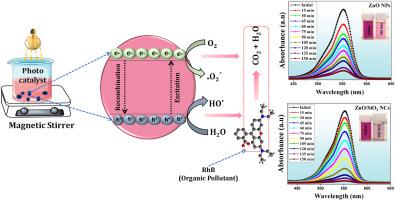探索使用插层 ZnO/SiO2 纳米复合材料光催化分解有机污染物
IF 4.3
3区 材料科学
Q2 MATERIALS SCIENCE, MULTIDISCIPLINARY
引用次数: 0
摘要
随着水源中有机污染物的日益普遍,有必要开发高效、经济的光催化剂来降解这些污染物。人们对氧化锌纳米粒子(NPs)的光催化性能进行了广泛的研究;然而,光催化效率低和光生载流子的高重组率阻碍了它们的应用。本手稿探讨了通过共沉淀和斯托伯方法相结合合成的插层 ZnO/SiO2 纳米复合材料 (NC) 的增强光催化性能,以解决这些难题。利用各种表征技术,包括 X 射线衍射 (XRD)、高分辨率透射电子显微镜 (HRTEM)、X 射线光电子能谱 (XPS)、紫外可见光谱法和布鲁瑙尔-艾美特-泰勒 (BET) 分析法,对氧化锌纳米粒子和氧化锌/二氧化硅纳米复合材料的结构、光学元素和形态特性进行了全面分析。通过 XRD 分析,ZnO NPs 和 ZnO/SiO₂ NCs 的计算结晶尺寸分别为 36 nm 和 39 nm。TEM 图像显示,ZnO NPs 和 ZnO/SiO₂ NCs 的结晶呈细长球形。XPS 和傅立叶变换红外分析提供了铜和硅在其 Zn2⁺和 Si⁴⁺ 氧化态存在的特征带细节。经计算,ZnO NPs 的光带隙能量为 3.38 eV,ZnO/SiO₂ NCs 的光带隙能量为 3.22 eV。ZnO/SiO2 NCs 的光催化效率得到了增强,在可见光下降解罗丹明 B (RhB) 的效率达到了 92%,而纯 ZnO NPs 的降解率相对较低,只有 81%,这是因为 ZnO NPs 的带隙较低、比表面积较大且电子-空穴重组率较低。BET 表面积测量显示,氧化锌纳米粒子的表面积为 11.234 m2/g,而氧化锌/SiO₂ NCs 的表面积为 57.118 m2/g,突出显示了 SiO₂ 的增强作用。这些 NCs 在降解过程中表现出卓越的重复使用性,可在多次循环中保持高效率。ZnO/SiO₂ NCs 清除超氧自由基的能力凸显了其在环境修复方面的有效性,尤其是在废水处理方面。本文章由计算机程序翻译,如有差异,请以英文原文为准。

Exploring the photocatalytic breakdown of organic pollutants using intercalated ZnO/SiO2 nanocomposites
The increasing prevalence of organic pollutants in water sources necessitates the development of efficient and cost-effective photocatalysts for their degradation. ZnO nanoparticles (NPs) have been widely studied for their photocatalytic properties; however, their application is hindered by low photocatalytic efficiency and high recombination rates of photogenerated carriers. This manuscript explores the enhanced photocatalytic performance of intercalated ZnO/SiO2 nanocomposites (NCs), synthesized through a combination of co-precipitation and Stöber methods, as a solution to these challenges. A comprehensive analysis of the structural, optical elemental and Morphological properties of both ZnO NPs and ZnO/SiO2 NCs was conducted using various characterization techniques, including X-ray diffraction (XRD), high-resolution transmission electron microscopy (HRTEM), X-ray photoelectron spectroscopy (XPS), UV–Vis spectrometry and Brunauer-Emmett-Teller (BET) analysis. Through, XRD analysis, the calculated crystallite sizes of ZnO NPs and ZnO/SiO₂ NCs were found to be 36 nm and 39 nm respectively. TEM images illustrated that the ZnO NPs and ZnO/SiO₂ NCs have crystallized in elongated spherical morphology. XPS and FTIR analyses provided the signature band details the presence of Cu and Si in their Zn2⁺ and Si⁴⁺ oxidation states. The optical bandgap energies were calculated to be 3.38 eV for ZnO NPs and 3.22 eV for ZnO/SiO₂ NCs. The enhanced photocatalytic efficiency of the ZnO/SiO2 NCs achieved an impressive degradation rate of 92 % for Rhodamine B (RhB), compared to a relatively lower rate of 81 % for pure ZnO NPs for the degradation of RhB under visible light due to its lower bandgap, high surface area, and lower electron-hole recombination rate. BET surface area measurements revealed that ZnO nanoparticles have a surface area of 11.234 m2/g, while ZnO/SiO₂ NCs show 57.118 m2/g, highlighting SiO₂'s enhancement. The NCs demonstrated exceptional reusability for degradation, sustaining high efficiency across multiple cycles. Its ability to scavenge superoxide radicals highlighted the effectiveness of the ZnO/SiO₂ NCs in environmental remediation, especially for wastewater treatment.
求助全文
通过发布文献求助,成功后即可免费获取论文全文。
去求助
来源期刊

Materials Chemistry and Physics
工程技术-材料科学:综合
CiteScore
8.70
自引率
4.30%
发文量
1515
审稿时长
69 days
期刊介绍:
Materials Chemistry and Physics is devoted to short communications, full-length research papers and feature articles on interrelationships among structure, properties, processing and performance of materials. The Editors welcome manuscripts on thin films, surface and interface science, materials degradation and reliability, metallurgy, semiconductors and optoelectronic materials, fine ceramics, magnetics, superconductors, specialty polymers, nano-materials and composite materials.
 求助内容:
求助内容: 应助结果提醒方式:
应助结果提醒方式:


